As part of our project I am currently thinking about the formative influences on David Lewis’ philosophy. I’m interested to discover how, why and when Lewis arrived at the doctrines he is most well-known for. I take his formative years to span more or less the 1960s. He was an undergraduate student at Swarthmore College, 1957-62, then a graduate student at Harvard University, 1962-67, and an Assistant Professor at UCLA, 1966-70. It was during this decade more or less that his philosophical system was born. Later developments, such as his admission of natural properties, are really refinements to the system he constructed during his formative years. (The word ‘system’ is not the best term, but let that pass.)
Naturally, we would give an account of the formation of Lewis’ philosophy by looking at the work of other philosophers, his teachers (Nelson Goodman, W.V. Quine, Donald C. Williams) and other dominant figures (Rudolf Carnap, Hume, F.P. Ramsey). However, in this post, I want to divert our attention away from philosophical influences and focus on the extent to which science fiction might have played a role in shaping some aspects of his philosophical outlook. I’ll do this by comparing three doctrines defended by Lewis with science fiction stories he read as a teenager and student. The philosophical doctrines are:
- Four-dimensionalism
- Counterpart Theory
- Life-everlasting (given the no-collapse interpretation of quantum mechanics)
My motivation is two-fold. First, given that one would naturally look at past philosophers in determining the influences on Lewis, non-philosophical connections might get overlooked. Second, some of the influence of science fiction on Lewis pre-dates any philosophical influences and these influences from science fiction seem to be reinforced or drawn upon as he develops philosophically as a student. So, if there are science fiction influences on Lewis, they are foundational.
In part 1 of this series I outline some of his early childhood interests in science and science fiction and then discuss (1). In a later post I will explore (2) and (3).
Childhood
As a little boy Lewis demonstrated his unique talents for mastering difficult subjects at a very early age. His interest in science fiction appears to have come from his interest in science. At the age of 14 Lewis wrote a detailed description of the major events of his life up to that point, with several remarks looking forward towards college, graduate school, and beyond. He called it his ‘Autobiography’. In it he describes how he first became interested in science in the first grade or thereabouts:
‘At about this time, when I was in the hospital having my tonsils out, I made the acquaintance of a set of little paper-backed science books, complete with lists of experiments. I read these avidly, and from them I gained my first knowledge of science. I am afraid that I made a great nuisance of myself when I pestered my mother to help me with my experiments’.
In the third grade or thereabouts he continued to pursue his interest in science by inventing small contraptions such as ‘the slot machine’ and ‘the better mousetrap’. The ‘better’ mousetrap was a device that was designed to drop a weight on the mouse’s head so as to stun it when it entered the trap. Lewis even had a go at inventing the telephone. He writes:
‘I had been told by a visitor to the family that the telephone was made from graphite, wire, and plastic. I would take a piece of wood, because I knew that wood was made in part out of carbon, and did not everyone know that graphite was a form of carbon? For my wire I took pieces of paper clips, and I had a fiber of some material which I believed to be plastic. I twisted these materials up together and held the resulting mess to my ear. Strange to say, I never heard a thing!’
In the sixth grade his family spent the year in Berkeley, California. While at school there Lewis got involved in the Junior Police, directing traffic near the school under the auspices of the local police department. He also got into flying gliders outside his house and watching trains come in to the nearby (Sante Fe) station. He continues:
‘My biggest interest that year, however, was space travel. For a while, I listened regularly to some radio programs. One of these, my favorite, was “Tom Corbett, Space Cadet”. After I had heard a few of these programs, I was always playing spaceship. Our house had a big utility room, all full of switches to be pushed and big rocket engines, which washed clothes at other times. The house had a speaking tube from the first floor to the second, and I had some electric train equipment which had colored lights and levers – altogether, all the essentials of a rocket cruiser’.
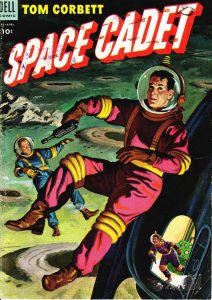
Tom Corbett, Space Cadet #9, Feb-Apr 1954
After the year was up Lewis’ family drove back to Oberlin, Ohio. Lewis was to start the seventh grade. Like any other boy or girl he exercised his imagination at play nearly all the time. He says of the long drive back east:
‘I enjoyed this trip, too, which was, I remember, also a rocket ship flight. It was my job to keep a log of the trip. I recorded times and mileages of important stops, and I kept a record of the family’s opinions of the motels, in case we should some day come that way again’.
His boyish love for space travel was coupled with his growing interest in science (especially chemistry) at Junior High School. He slowly turned the basement of his family home into a chemistry laboratory, complete with equipment sourced from the school, the principal, and the Oberlin college laboratory.
In the 1940s and 1950s science fiction writing was at its peak in the US, with monthly science-fiction magazines, such as Astounding Science Fiction, Unknown Fantasy Fiction, and Galaxy Science Fiction and countless anthologies, e.g., Science Fiction Hall of Fame, Best from Fantasy and Science Fiction, and Famous Science-Fiction Stories, rolling off the press colourful illustrations and all. Many boys, teenagers, and young adults grew up on this material. Lewis was among them. At Swarthmore he read heaps of science fiction stories from these magazines and anthologies. While he was at Harvard he regularly attended meetings at the MIT Science Fiction Society where he partook in serious discussions about the concepts expressed and problems raised in science fiction. As Lewis was developing philosophically at Swarthmore and Harvard he would appeal to and draw from science fiction.
Time Travel
One science fiction topic that interested Lewis greatly was time travel. In particular, Lewis was drawn towards Robert A. Heinlein’s time travel stories: ‘By His Bootstraps’ (in Famous Science-Fiction Stories, 1957) and ‘–All You Zombies–’ (in Best from Fantasy and Science Fiction, 1960). The first story begins with Bob Wilson stuck in the predicament of having to write his thesis from scratch the night before it is due. The title is ‘An Investigation into Certain Mathematical Aspects of a Rigor of Metaphysics’. However, a stranger from the future interrupts him and explains how he travelled back into the past through a ‘time gate’. And the story goes on getting more and more complex (I won’t wreck it for you). This tale would have resonated with Lewis on many levels.
While at Swarthmore Lewis makes a passing reference to time travel in connection with reversed causation in a letter to Michael Scriven. He says:
‘We are never forced to the notion of reversed cause: we can always say that a present event changes all the evidences of the past, but changes them just after it happens. The question of whether the past is changed when all its evidence is (coherently) changed is senseless, a “wheel that turns by itself”. What do we have the past tense language for, anyway? The S-F time travel paradoxes do not arise simply because the past is changed, but because all the evidences of the past are changed instantly, thus abolishing the act of changing them. They are paradoxes of instantaneous, not of reversed, causation’ (Letter to Michael Scriven, 7 January 1961, his italics).
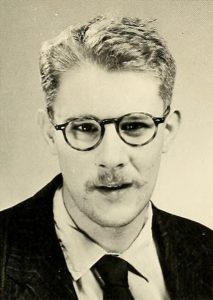
David Lewis, Swarthmore Yearbook, 1962
He must have had Heinlein’s stories in mind. Later on, 1968-69, Lewis argued in informal lectures at UCLA that Heinlein’s time travel stories are consistent and metaphysically possible. His Gavin David Young Lectures at the University of Adelaide July 1971 were on ‘The Paradoxes of Time Travel’, which featured these two time travel stories by Heinlein. In 1976 he published ‘The Paradoxes of Time Travel’ (Amer. Phil. Q).
On Lewis’ view, the world is a four-dimensional manifold of events. Time is just another dimension of extent, like the three dimensions of space. An object or thing persists by having temporal parts at each time it exists. David Lewis, for example, is a four-dimensional object that is composed of temporal parts, the first of which existed in 1941 and the last of which existed in 2001. He is a time-like streak. A time traveller is similar to an ordinary person in that the time traveller is a four-dimensional object embedded in the manifold, however the time traveller is a broken streak or a zig-zag streak (‘By His Bootstraps’ involves time travellers of the former variety).
Quine and Williams defended four-dimensionalism and endorsed the doctrine of temporal parts and there are clear connections between Quine and Williams and Lewis in this respect – especially Williams who likewise argued that time travel is metaphysically possible. The novel aspect of Lewis’ theory is that he accommodated for broken streaks whereas Williams was more concerned with capturing time travel as described by H.G. Wells – Wellsian time travel involves zig-zag streaks.
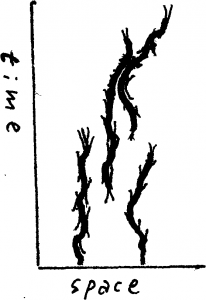
Figure from Lewis’ Gavin David Young Lectures, July 1971
Heinlein not only described consistent time travel stories he also imagined them within a four-dimensional framework. In ‘By His Bootstraps’ Bob Wilson reflects on the scenario in which he meets himself from other times and asks:
‘Which one was himself?
He was all of them, he knew, for he remembered being each one. How about the times when there had been more than one present?
By sheer necessity he was forced to expand the principle of non-identity—“Nothing is identical with anything else, not even with itself”—to include the ego. In a four-dimensional continuum each event is an absolute individual, it has its space co-ordinates and its date. The Bob Wilson he was right now was not the Bob Wilson he had been ten minutes ago. Each was a discrete section of a four-dimensional process. One resembled the other in many particulars, as one slice of bread resembles the slice next to it. But they were not the same Bob Wilson—they differed by a length of time’ (1957, pp. 925-6, italics in original).
This is an avowal of the doctrine of temporal parts.
Heinlein considers also the question of whether higher dimensions of time are required for the four-dimensional manifold to fold in such way for time travel to occur. Bob Wilson wonders thus:
‘If higher dimensions were required to “hold” a four-dimensional continuum, then the number of dimensions of space and of time were necessarily infinite; each order requires the next higher order to maintain it.
But “infinite” was another meaningless term. “Open series” was a little better, but not much’ (1957, p. 924).
In his wonderment Bob Wilson is grasping at the idea that a hypertime in which time moved would lead to an infinite regress of hypertimes. Obviously, Heinlein does not argue for and defend the thesis that there is no real passage of time (since it is after all a story not a philosophy paper) and in the following section Bob Wilson speculates that there must be another dimension in which the creators of the time gates resided (1957, p. 924). Nonetheless, however strained by the genre, Heinlein is expressing vaguely philosophical concepts about the metaphysics of time and gesturing towards arguments that are seriously discussed in philosophy. The infinite regress argument against hypertime was put forth by Williams (‘The Myth of Passage’, J. Phil. 1951, pp. 463-4). In his Gavin David Young Lectures Lewis presents the same argument.
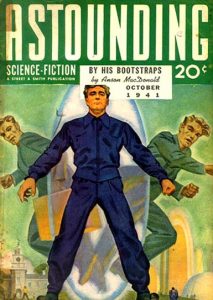
Astounding Science Fiction, October 1941
Another point of comparison is that of closed causal loops. In ‘The Paradoxes of Time Travel’ Lewis admits closed causal chains – Bob Wilson is a case in point. And Heinlein is aware of the oddity:
‘Wilson took a deep breath, and got control of himself. Then he reached back into his academic philosophical concepts and produced the notion he had been struggling to express. “It denies all reasonable theories of causation. You would have me believe that causation can be completely circular. I went through because I came back from going through to persuade myself to go through. That’s silly”
“Well, didn’t you?”Wilson did not have an answer ready for that one. Diktor continued with, “Don’t worry about it. The causation you have been accustomed to is valid enough in its own field but is simply a special case under the general case. …”’ (1957, p. 902).
Lewis attempts to allay concerns about any weird consequences of closed causal chains. One potential worry is that closed causal chains do not have a genuine ground. If A causes B and B causes C but C causes A, there is no bedrock in which to ground the chain. Lewis points out that each event in the chain is explained by the previous event but admits that the chain itself is unexplained. However, he thinks such a case is no different to the case of God, the Big Bang, or the infinite past of the universe (Lewis 1976, 149). If we don’t object to the bruteness in any one of these cases, we should not object to the bruteness of closed causal loops.
In sum, the influence of Heinlein on Lewis complemented the relevant philosophical influences and reinforced the four-dimensionalist picture of reality in Lewis’ mind. Furthermore, Lewis improves upon Heinlein’s description of time travel and fills out the basic concepts fully and within a sophisticated philosophical context. In the next part of this series I will look at counterpart theory and the thesis that we should expect to survive indefinitely in light of Lewis’ reading of science fiction.

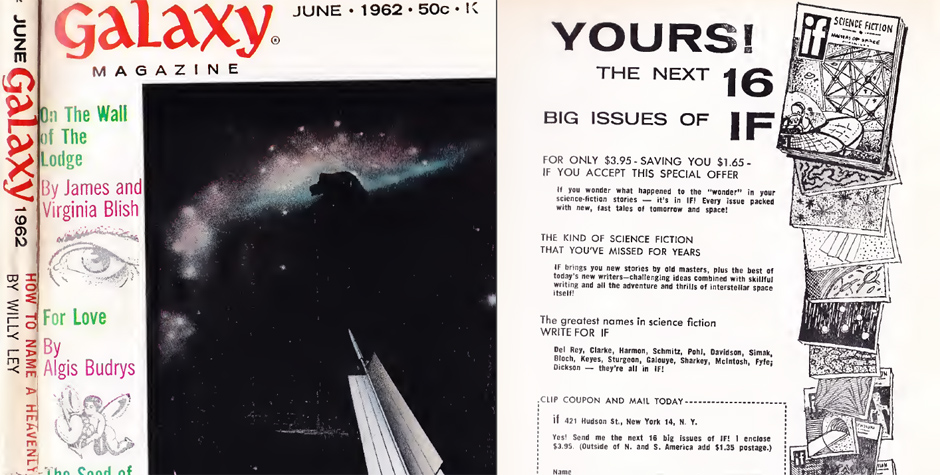

On Heinlein and Lewis: when I applied for graduate school at Princeton in the mid-80s, David Lewis was the graduate director. One of my writing samples was a paper on time travel that focused on his paradoxes paper (together with Putnam’s “Ain’t Necessarily So” paper), arguing against both that time travel was inconsistent. David took the time to write me a generous letter mentioning that I might be especially interested in the Heinlein story “By His Own Bootstraps”–especially given that my namesake was the main protagonist!
When I sent Lewis a copy of my ‘Travelling in Time’ (Analysis 1980) he didn’t respond to my arguments (which he no doubt thought were underwhelming); he just sent me a copy of Heinlein’s ‘By His Bootstraps’!